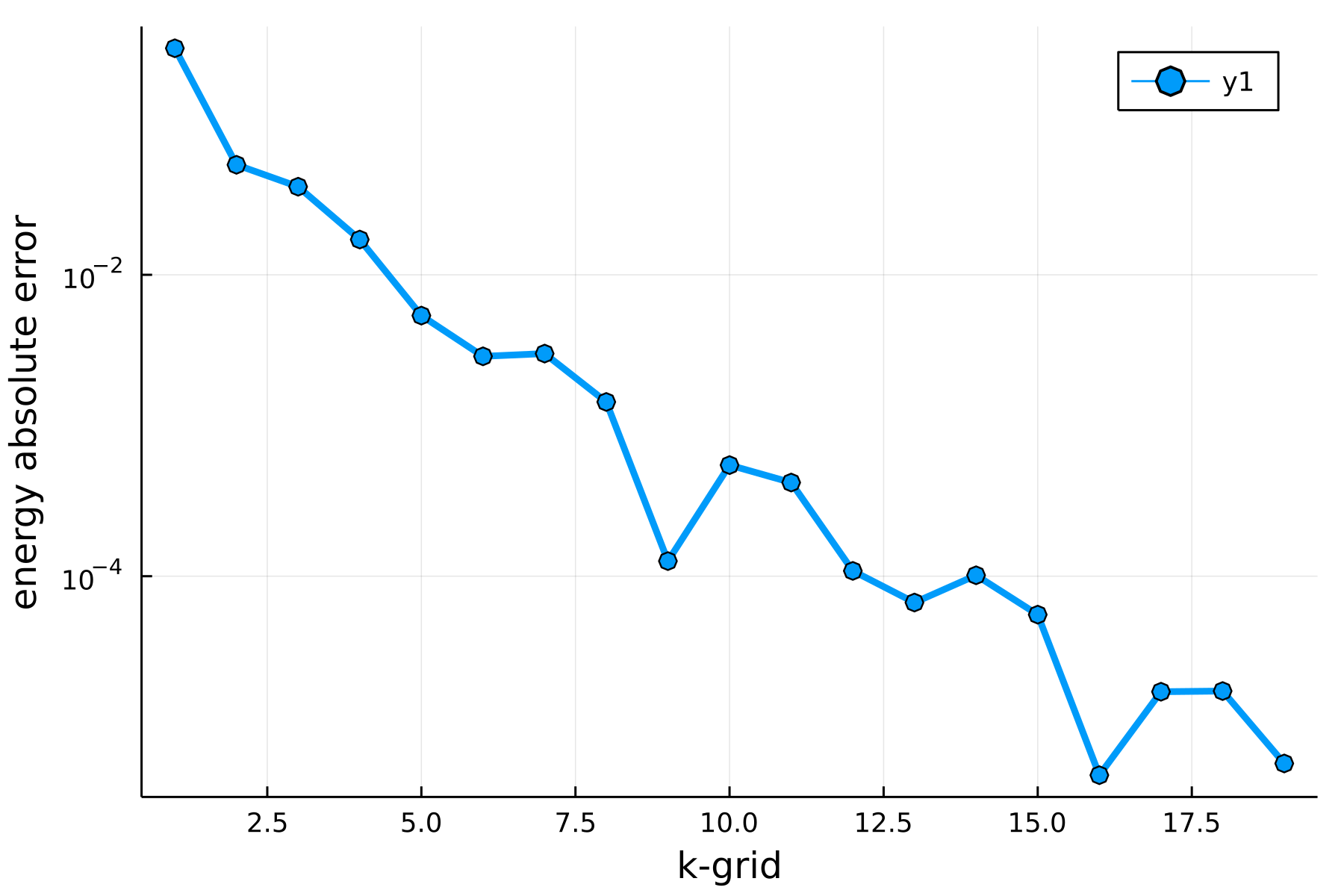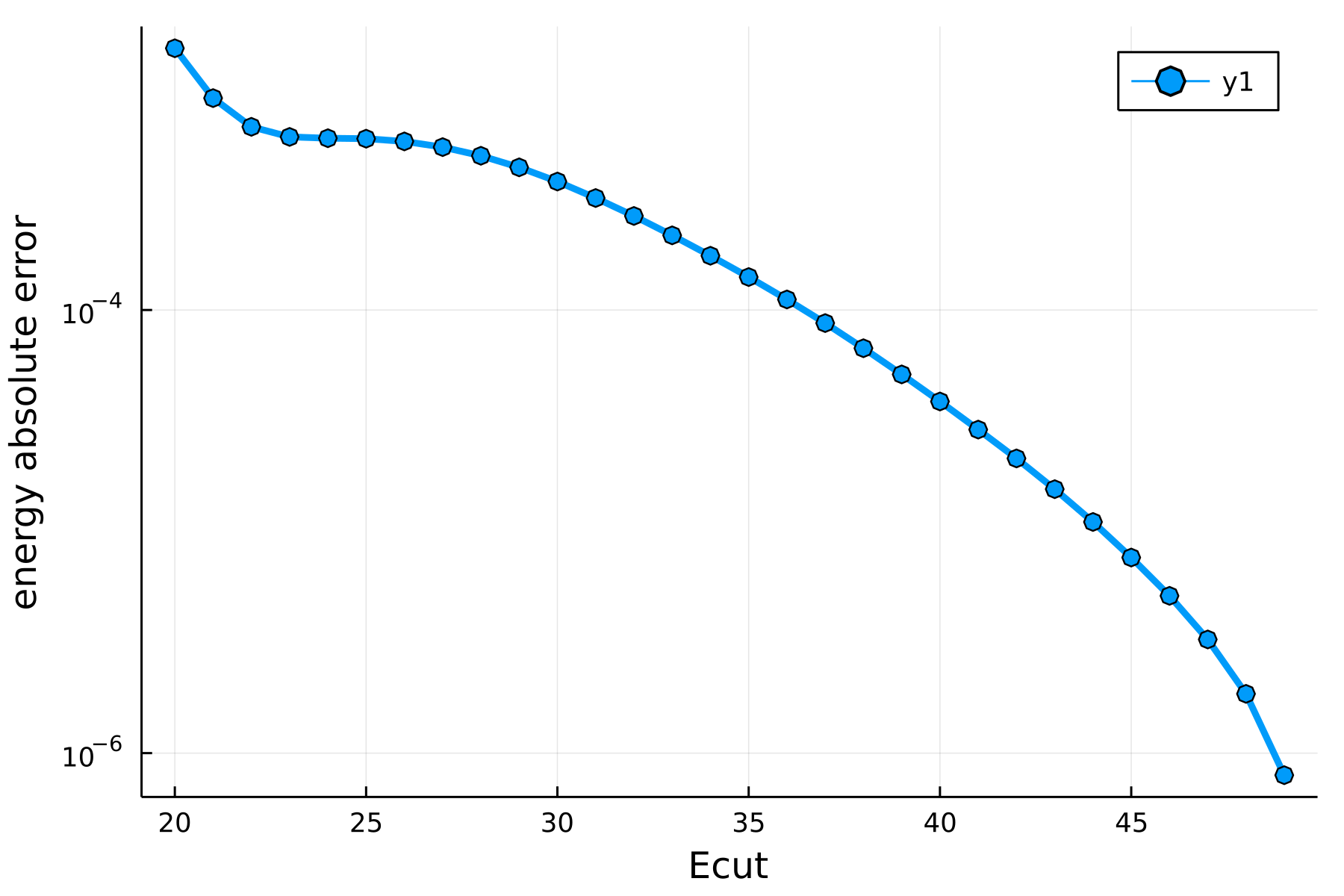Performing a convergence study¶
This example shows how to perform a convergence study to find an appropriate
discretisation parameters for the Brillouin zone (kgrid) and kinetic energy
cutoff (Ecut), such that the simulation results are converged to a desired
accuracy tolerance.
Such a convergence study is generally performed by starting with a
reasonable base line value for kgrid and Ecut and then increasing these
parameters (i.e. using finer discretisations) until a desired property (such
as the energy) changes less than the tolerance.
This procedure must be performed for each discretisation parameter. Beyond
the Ecut and the kgrid also convergence in the smearing temperature or
other numerical parameters should be checked. For simplicity we will neglect
this aspect in this example and concentrate on Ecut and kgrid. Moreover
we will restrict ourselves to using the same number of k-points in each
dimension of the Brillouin zone.
As the objective of this study we consider bulk platinum. For running the SCF conveniently we define a function:
using DFTK
using LinearAlgebra
using Statistics
using PseudoPotentialData
function run_scf(; a=5.0, Ecut, nkpt, tol)
pseudopotentials = PseudoFamily("cp2k.nc.sr.lda.v0_1.largecore.gth")
atoms = [ElementPsp(:Pt, pseudopotentials)]
position = [zeros(3)]
lattice = a * Matrix(I, 3, 3)
model = model_DFT(lattice, atoms, position;
functionals=LDA(), temperature=1e-2)
basis = PlaneWaveBasis(model; Ecut, kgrid=(nkpt, nkpt, nkpt))
println("nkpt = $nkpt Ecut = $Ecut")
self_consistent_field(basis; is_converged=ScfConvergenceEnergy(tol))
end;
Moreover we define some parameters. To make the calculations run fast for the
automatic generation of this documentation we target only a convergence to
1e-2. In practice smaller tolerances (and thus larger upper bounds for
nkpts and Ecuts are likely needed.
tol = 1e-2 # Tolerance to which we target to converge
nkpts = 1:7 # K-point range checked for convergence
Ecuts = 10:2:24; # Energy cutoff range checked for convergence
As the first step we converge in the number of k-points employed in each dimension of the Brillouin zone …
function converge_kgrid(nkpts; Ecut, tol)
energies = [run_scf(; nkpt, tol=tol/10, Ecut).energies.total for nkpt in nkpts]
errors = abs.(energies[1:end-1] .- energies[end])
iconv = findfirst(errors .< tol)
(; nkpts=nkpts[1:end-1], errors, nkpt_conv=nkpts[iconv])
end
result = converge_kgrid(nkpts; Ecut=mean(Ecuts), tol)
nkpt_conv = result.nkpt_conv
nkpt = 1 Ecut = 17.0 n Energy log10(ΔE) log10(Δρ) Diag Δtime --- --------------- --------- --------- ---- ------ 1 -26.49622281284 -0.22 8.0 110ms 2 -26.59233656940 -1.02 -0.63 2.0 158ms 3 -26.61290867394 -1.69 -1.41 2.0 33.9ms 4 -26.61326615223 -3.45 -2.13 2.0 31.5ms nkpt = 2 Ecut = 17.0 n Energy log10(ΔE) log10(Δρ) Diag Δtime --- --------------- --------- --------- ---- ------ 1 -25.79261308699 -0.09 5.2 86.2ms 2 -26.23307917121 -0.36 -0.70 2.0 56.2ms 3 -26.23823144216 -2.29 -1.32 2.0 68.0ms 4 -26.23848096839 -3.60 -2.32 1.0 48.0ms nkpt = 3 Ecut = 17.0 n Energy log10(ΔE) log10(Δρ) Diag Δtime --- --------------- --------- --------- ---- ------ 1 -25.78404837737 -0.09 5.0 79.2ms 2 -26.24025048195 -0.34 -0.80 2.0 57.1ms 3 -26.25080534270 -1.98 -1.65 2.2 61.3ms 4 -26.25104937780 -3.61 -2.22 1.0 46.1ms nkpt = 4 Ecut = 17.0 n Energy log10(ΔE) log10(Δρ) Diag Δtime --- --------------- --------- --------- ---- ------ 1 -25.91216018156 -0.11 5.2 186ms 2 -26.29428038427 -0.42 -0.77 2.0 116ms 3 -26.30833081937 -1.85 -1.74 2.2 147ms 4 -26.30842515507 -4.03 -2.66 1.0 91.4ms nkpt = 5 Ecut = 17.0 n Energy log10(ΔE) log10(Δρ) Diag Δtime --- --------------- --------- --------- ---- ------ 1 -25.90303612261 -0.11 4.0 154ms 2 -26.26717129897 -0.44 -0.72 2.0 115ms 3 -26.28543617491 -1.74 -1.64 2.1 156ms 4 -26.28571178256 -3.56 -2.28 1.0 346ms nkpt = 6 Ecut = 17.0 n Energy log10(ΔE) log10(Δρ) Diag Δtime --- --------------- --------- --------- ---- ------ 1 -25.87574090843 -0.10 5.0 319ms 2 -26.27389455410 -0.40 -0.77 1.9 208ms 3 -26.28808182713 -1.85 -1.71 2.2 228ms 4 -26.28818803673 -3.97 -2.62 1.0 162ms nkpt = 7 Ecut = 17.0 n Energy log10(ΔE) log10(Δρ) Diag Δtime --- --------------- --------- --------- ---- ------ 1 -25.89625074297 -0.11 3.5 249ms 2 -26.27883476796 -0.42 -0.75 2.0 187ms 3 -26.29413133618 -1.82 -1.74 2.1 206ms 4 -26.29420603226 -4.13 -2.65 1.0 145ms
5
… and plot the obtained convergence:
using Plots
plot(result.nkpts, result.errors, dpi=300, lw=3, m=:o, yaxis=:log,
xlabel="k-grid", ylabel="energy absolute error")
We continue to do the convergence in Ecut using the suggested k-point grid.
function converge_Ecut(Ecuts; nkpt, tol)
energies = [run_scf(; nkpt, tol=tol/100, Ecut).energies.total for Ecut in Ecuts]
errors = abs.(energies[1:end-1] .- energies[end])
iconv = findfirst(errors .< tol)
(; Ecuts=Ecuts[1:end-1], errors, Ecut_conv=Ecuts[iconv])
end
result = converge_Ecut(Ecuts; nkpt=nkpt_conv, tol)
Ecut_conv = result.Ecut_conv
nkpt = 5 Ecut = 10 n Energy log10(ΔE) log10(Δρ) Diag Δtime --- --------------- --------- --------- ---- ------ 1 -25.57872512129 -0.16 3.8 71.9ms 2 -25.77769551126 -0.70 -0.77 1.9 62.2ms 3 -25.78625859012 -2.07 -1.84 2.0 55.0ms 4 -25.78631683642 -4.23 -2.92 1.0 39.8ms nkpt = 5 Ecut = 12 n Energy log10(ΔE) log10(Δρ) Diag Δtime --- --------------- --------- --------- ---- ------ 1 -25.78654140009 -0.12 3.5 72.4ms 2 -26.07741828524 -0.54 -0.72 2.0 51.7ms 3 -26.09341840274 -1.80 -1.68 2.1 58.5ms 4 -26.09373823994 -3.50 -2.34 1.0 47.6ms 5 -26.09375339053 -4.82 -2.69 1.2 44.1ms nkpt = 5 Ecut = 14 n Energy log10(ΔE) log10(Δρ) Diag Δtime --- --------------- --------- --------- ---- ------ 1 -25.86811691876 -0.11 3.8 57.8ms 2 -26.20928967215 -0.47 -0.72 2.0 43.6ms 3 -26.22669884375 -1.76 -1.65 2.1 46.4ms 4 -26.22700683213 -3.51 -2.29 1.0 30.6ms 5 -26.22702540241 -4.73 -2.67 1.1 33.5ms nkpt = 5 Ecut = 16 n Energy log10(ΔE) log10(Δρ) Diag Δtime --- --------------- --------- --------- ---- ------ 1 -25.89739755582 -0.11 4.0 140ms 2 -26.25750588653 -0.44 -0.72 2.0 107ms 3 -26.27559557448 -1.74 -1.65 2.1 114ms 4 -26.27587559648 -3.55 -2.29 1.0 84.1ms 5 -26.27589251535 -4.77 -2.69 1.0 83.3ms nkpt = 5 Ecut = 18 n Energy log10(ΔE) log10(Δρ) Diag Δtime --- --------------- --------- --------- ---- ------ 1 -25.90595596209 -0.11 4.1 143ms 2 -26.27276495544 -0.44 -0.72 2.0 106ms 3 -26.29101700489 -1.74 -1.64 2.2 126ms 4 -26.29128601834 -3.57 -2.29 1.0 82.4ms 5 -26.29130327946 -4.76 -2.69 1.0 112ms nkpt = 5 Ecut = 20 n Energy log10(ΔE) log10(Δρ) Diag Δtime --- --------------- --------- --------- ---- ------ 1 -25.90859517574 -0.11 4.0 142ms 2 -26.27703098050 -0.43 -0.72 2.0 104ms 3 -26.29532779943 -1.74 -1.64 2.3 117ms 4 -26.29558675868 -3.59 -2.28 1.0 88.4ms 5 -26.29560492317 -4.74 -2.70 1.0 117ms nkpt = 5 Ecut = 22 n Energy log10(ΔE) log10(Δρ) Diag Δtime --- --------------- --------- --------- ---- ------ 1 -25.90925442621 -0.11 4.0 160ms 2 -26.27822851988 -0.43 -0.73 2.0 119ms 3 -26.29617887456 -1.75 -1.65 2.2 132ms 4 -26.29641976381 -3.62 -2.31 1.0 89.9ms 5 -26.29643485241 -4.82 -2.70 1.2 98.6ms nkpt = 5 Ecut = 24 n Energy log10(ΔE) log10(Δρ) Diag Δtime --- --------------- --------- --------- ---- ------ 1 -25.90938405562 -0.11 4.1 143ms 2 -26.27826346980 -0.43 -0.73 2.0 113ms 3 -26.29625175155 -1.75 -1.64 2.2 114ms 4 -26.29649519193 -3.61 -2.30 1.0 82.1ms 5 -26.29651079827 -4.81 -2.70 1.2 88.1ms
18
… and plot it:
plot(result.Ecuts, result.errors, dpi=300, lw=3, m=:o, yaxis=:log,
xlabel="Ecut", ylabel="energy absolute error")
A more realistic example.¶
Repeating the above exercise for more realistic settings, namely …
tol = 1e-4 # Tolerance to which we target to converge
nkpts = 1:20 # K-point range checked for convergence
Ecuts = 20:1:50;
…one obtains the following two plots for the convergence in kpoints and Ecut.

